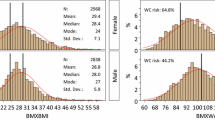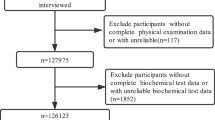Abstract
Background
The Kailuan Study examined cardiovascular risk factors in a Chinese cohort comprising employees of the Kailuan Coal Group who underwent regular health examinations.
Patients and methods
Normotensive participants in the Kailuan study were enrolled in the present work and followed up for a median of 5.8 years to assess the development of hypertension (systolic blood pressure [SBP] ≥140 mmHg, diastolic blood pressure [DBP] ≥90 mmHg, or initiation of blood pressure [BP] medications).
Results
This study comprised a total of 50,024 participants (age, 47.9 ± 12.0 years; male/female, 37,429/12,595), of whom 22,176 (44.3%) developed hypertension. In both male and female subjects, there was an increase in multivariable-adjusted hazard ratios for hypertension in all waist circumference (WC) groups (group 1, <70 cm; group 2, 70–79 cm; group 3, 80–89 cm; group 4, 90–99 cm; group 5, ≥100 cm). Results of a stratified analysis of subjects with normal body mass index (BMI; <24 kg/m2) showed that hazard ratios for hypertension still increased across WC groups. Significant interactions were found between WC groups and gender (p <0.001), as well as between WC groups and BP categories (p <0.001). Increased WC was associated with a significantly higher risk of hypertension incidence in men compared with women and in subjects with a high–normal BP vs. those with an ideal BP.
Conclusion
WC is an independent predictor of hypertension incidence. The association between WC and hypertension incidence is affected by gender and baseline BP levels.
Zusammenfassung
Hintergrund
In der Kailuan-Studie wurden die kardiovaskulären Risikofaktoren in einer chinesischen Kohorte untersucht, die aus Mitarbeitern der Kailuan Coal Group bestand und regelmäßig auf ihren Gesundheitszustand hin untersucht wurde.
Patienten und Methoden
Normotensive Teilnehmer der Kailuan-Studie wurden in die vorliegende Studie aufgenommen und im Mittel 5,8 Jahre lang nachbeobachtet, um zu ermitteln, ob sich eine Hypertonie entwickelte (systolischer Blutdruck ≥140 mmHg, diastolischer Blutdruck ≥90 mmHg oder Beginn der Gabe von Blutdruckmedikamenten).
Ergebnisse
Insgesamt wurden 50.024 Teilnehmer in diese Studie aufgenommen (Alter: 47,9 ± 12,0 Jahre; m./w.: 37.429/12.595), davon entwickelten 22.176 (44,3%) eine Hypertonie. Sowohl bei männlichen als auch bei weiblichen Probanden gab es einen Anstieg der multivariabel angepassten Hazard-Ratio für Hypertonie in allen nach Taillenumfang unterteilten Gruppen (Gruppe 1: <70 cm; Gruppe 2: 70–79 cm; Gruppe 3: 80–89 cm; Gruppe 4: 90–99 cm; Gruppe 5: ≥100 cm). Ergebnisse einer stratifizierten Auswertung von Probanden mit normalem Body-Mass-Index (BMI; <24 kg/m2) zeigten, dass die Hazard-Ratio für Hypertonie quer durch die nach Taillenumfang unterteilten Gruppen weiterhin anstieg. Signifikante Wechselwirkungen fanden sich zwischen nach Taillenumfang unterteilten Gruppen und Geschlecht (p <0,001) sowie zwischen nach Taillenumfang unterteilten Gruppen und Blutdruckkategorie (p <0,001). Ein erhöhter Taillenumfang ging mit einem signifikant erhöhten Inzidenzrisiko für Hypertonie bei Männern im Vergleich zu Frauen sowie bei Probanden mit einem hochnormalen Blutdruck gegenüber Probanden mit idealen Blutdruckwerten einher.
Schlussfolgerung
Der Taillenumfang ist ein unabhängiger Prädiktor für die Inzidenz der Hypertonie. Der Zusammenhang zwischen Taillenumfang und Inzidenz der Hypertonie wird durch Geschlecht und Ausgangsblutdruckwerte beeinflusst.

Similar content being viewed by others
References
Folsom ARPR, Kaye SA, Munger RG (1990) Incidence of hypertension and stroke in relation to body fat distribution and other risk factors in older women. Stroke 21:701–706
Rimm EBSM, Giovannucci E, Ascherio A, Spiegelman D, Colditz GA, Willett WC (1995) Body size and fat distribution as predictors of coronary heart disease among middle-aged and older us men. Am J Epidemiol 141:1117–1127
Rexrode KMCV, Hennekens CH, Walters EE, Colditz GA, Stampfer MJ, Willett WC, Manson JE (1998) Abdominal adiposity and coronary heart disease in women. JAMA 280:1843–1848
Harris MMSJ, Thomas N, Schreiner P, Folsom AR (2000) Associations of fat distribution and obesity with hypertension in a bi-ethnic population: the aric study. Atherosclerosis risk in communities study. Obes Res 8:516–524
Wang YRE, Stampfer MJ, Willett WC, Hu FB (2005) Comparison of abdominal adiposity and overall obesity in predicting risk of type 2 diabetes among men. Am J Clin Nutr 81:555–563
Folsom ARKL, Anderson KE, Mink PJ, Olson JE, Hong CP, Sellers TA, Lazovich D, Prineas RJ (2000) Associations of general and abdominal obesity with multiple health outcomes in older women: The iowa women’s health study. Arch Intern Med 160:2117–2128
Nishida CGK (2010) S Kumanyika Body fat distribution and noncommunicable diseases in populations: overview of the 2008 who expert consultation on waist circumference and waist-hip ratio. Eur J Clin Nutr 64:2–5
Huxley RSM, Zheleznyakov E, Reddy S, Chan J (2010) Body mass index, waist circumference and waist:hip ratio as predictors of cardiovascular risk – a review of the literature. Eur J Clin Nutr 64:16–22
Lear SAPJ, Ko GT, Kumanyika S (2010) Appropriateness of waist circumference and waist-to-hip ratio cutoffs for different ethnic groups. Eur J Clin Nutr 64:42–61
Seidell J (2010) Waist circumference and waist/hip ratio in relation to all-cause mortality, cancer and sleep apnea. Eur J Clin Nutr 64:35–41
Qiao QRN (2010) The optimal cutoff values and their performance of waist circumference and waist-to-hip ratio for diagnosing type II diabetes. Eur J Clin Nutr 64:23–29
Stevens JEK, Huxley RR (2010) Associations between gender, age and waist circumference. Eur J Clin Nutr 64:6–15
Alberti KGMMPZ, Shaw J (2006) Metabolic syndrome-a new world-wide definition. A consensus statement from the International Diabetes Federation. Diabet Med 23:469–480
Bei-Fan Z, The Cooperative Meta-analysis Group of Working Group on Obesity in China (2002) Predictive values of body mass index and waist circumference for risk factors of certain related diseases in chinese adults: Study on optimal cut-off points of body mass index and waist circumference in chinese adults. Asia Pac J Clin Nutr 11:685–S693
Meng Peng SW, Jiang X, Jin C, Zhang W, Kailuan Cardiovascular Survey Group (2013) Long-term alcohol consumption is an independent risk factor of hypertension development in Northern China: Evidence from Kailuan Study. J Hypertens 31:2342–2347
Shouling Wu ZH, Yang X, Zhou Y, Wang A, Chen L, Zhao H, Ruan C, Wu Y, Xin A, Li K, Jin C, Cai J (2012) Prevalence of ideal cardiovascular health and its relationship with the 4‑year cardiovascular events in a northern chinese industrial city. Circ Cardiovasc Qual Outcomes 5:487–493
Shouling Wu YL, Jin C, Yang P, Li D, Li H, Shen C (2012) Intra-individual variability of high-sensitivity c‑reactive protein in chinese general population. Int J Cardiol 157:75–79
Wang FSW, Song Y, Tang X, Marshall R, Liang M, Wu Y, Qin X, Chen D, Hu Y (2009) Waist circumference, body mass index and waist to hip ratio for prediction of the metabolic syndrome in chinese. Nutrition Metab Cardiovasc Dis 19:542–547
Working Group on Obesity in China DoDC MoH (2004) The guidelines for prevention and control of overweight and obesity in chinese adults. Biomed Environ Sci 17:1–35
Bombelli MRF, Sega R, Carugo S, Fodri D, Brambilla G, Giannattasio C, Grassi G, Mancia G (2011) Impact of body mass index and waist circumference on the long-term risk of diabetes mellitus, hypertension, and cardiac organ damage. Hypertension 58:1029–1035
Levine DADAC, Prineas RJ, Cushman M, Howard VJ, Howard G (2011) Moderate waist circumference and hypertension prevalence: The regards study. Am J Hypertens 24:482–488
Bao YLJ, Wang C, Yang M, Li H, Zhang X, Zhu J, Lu H, Jia W, Xiang K (2008) Optimal waist circumference cutoffs for abdominal obesity in chinese. Atherosclerosis 201:378–384
Lin WYLL, Chen CY, Lo H, Hsia HH, Liu IL, Lin RS, Shau WY, Huang KC (2002) Optimal cut-off values for obesity: Using simple anthropometric indices to predict cardiovascular risk factors in taiwan. Int J Obes Relat Metab Disord 26:1232–1238
Ko GTCJ, Cockram CS, Woo J (1999) Prediction of hypertension, diabetes, dyslipidaemia or albuminuria using simple anthropometric indexes in hong kong chinese. Int J Obes Relat Metab Disord 23:1136–1142
Deurenberg-Yap MCS, Lin VF, Tan BY, van Staveren WA, Deurenberg P (2001) Relationships between indices of obesity and its co-morbidities in multi-ethnic singapore. Int J Obes Relat Metab Disord 25:1554–1562
Bei-Fan Z (2002) Predictive values of body mass index and waist circumference for risk factors of certain related diseases in chinese adults: Study on optimal cut-off points of body mass index and waist circumference in chinese adults. Asia Pac J Clin Nutr 11:S685–S693
Diaz VA, Baker R, Carnemolla M, Majeed A (2007) How does ethnicity affect the association between obesity and diabetes? Diabet Med 24:1199–1204
Ko GTTJ (2007) Waist circumference and bmi cut-off based on 10-year cardiovascular risk: evidence for ’central pre-obesity’. Obesity (Silver Spring) 15:2832–2839
Li RLW, Jia J, Zhang S, Shi L, Li Y, Yang Q, Kan H (2008) Relationships between indices of obesity and its cardiovascular comorbidities in a chinese population. Circ J 72:973–978
Mathieu PPP, Pibarot P, Lemieux I, Després JP (2009) Visceral obesity: The link among inflammation, hypertension, and cardiovascular disease. Hypertension 53:577–584
Paulmyer-Lacroix OBS, Oliver C, Alessi MC, Grino M (2002) Expression of the mrna coding for 11beta-hydroxysteroid dehydrogenase type 1 in adipose tissue from obese patients: an in situ hybridization study. J Clin Endocrinol Metab 87:2701–2705
Furukawa SFT, Shimabukuro M, Iwaki M, Yamada Y, Nakajima Y, Nakayama O, Makishima M, Matsuda M, Shimomura I (2004) Increased oxidative stress in obesity and its impact on metabolic syndrome. J Clin Invest 114:1752–1761
DiBona GF (2004) The sympathetic nervous system and hypertension: Recent developments. Hypertension 43:147–150
Furuhashi MUN, Higashiura K, Murakami H, Tanaka M, Moniwa N, Yoshida D, Shimamoto K (2003) Blockade of the renin-angiotensin system increases adiponectin concentrations in patients with essential hypertension. Hypertension 42:76–81
Funding
The study was funded by China’s National Key Technology Support Program during the 12th 5‑year plan period: Study, Evaluation and Popularization of Hypertension Technologies in Prevention and Treatment Among Communities (SEP-HTC).
Author information
Authors and Affiliations
Corresponding author
Ethics declarations
Conflict of interest
H. Sun, M. Zheng, S. Wu, M. Chen, J. Cai, and X. Yang declare that they have no competing interests.
The study was performed according to the guidelines of Helsinki Declaration and was approved jointly by the Ethics Committee of the Kailuan General Hospital and Beijing Chaoyang Hospital. Written informed consent was obtained from all participants.
Additional information
Author contributions Study design: Xinchun Yang, Jun Cai; literature research: Hao Sun, Meili Zheng; data acquisition: Shouling Wu, Meili Zheng; data analysis/interpretation: Meili Zheng; manuscript editing: Hao Sun; manuscript revision/review: Xinchun Yang
Rights and permissions
About this article
Cite this article
Sun, H., Zheng, M., Wu, S. et al. Waist circumference and incidence of hypertension in Chinese adults. Herz 42, 677–683 (2017). https://doi.org/10.1007/s00059-016-4501-x
Received:
Revised:
Accepted:
Published:
Issue Date:
DOI: https://doi.org/10.1007/s00059-016-4501-x




